DODGE CALIBER 2010 1.G Service Manual
Manufacturer: DODGE, Model Year: 2010, Model line: CALIBER, Model: DODGE CALIBER 2010 1.GPages: 484, PDF Size: 6.43 MB
Page 41 of 484
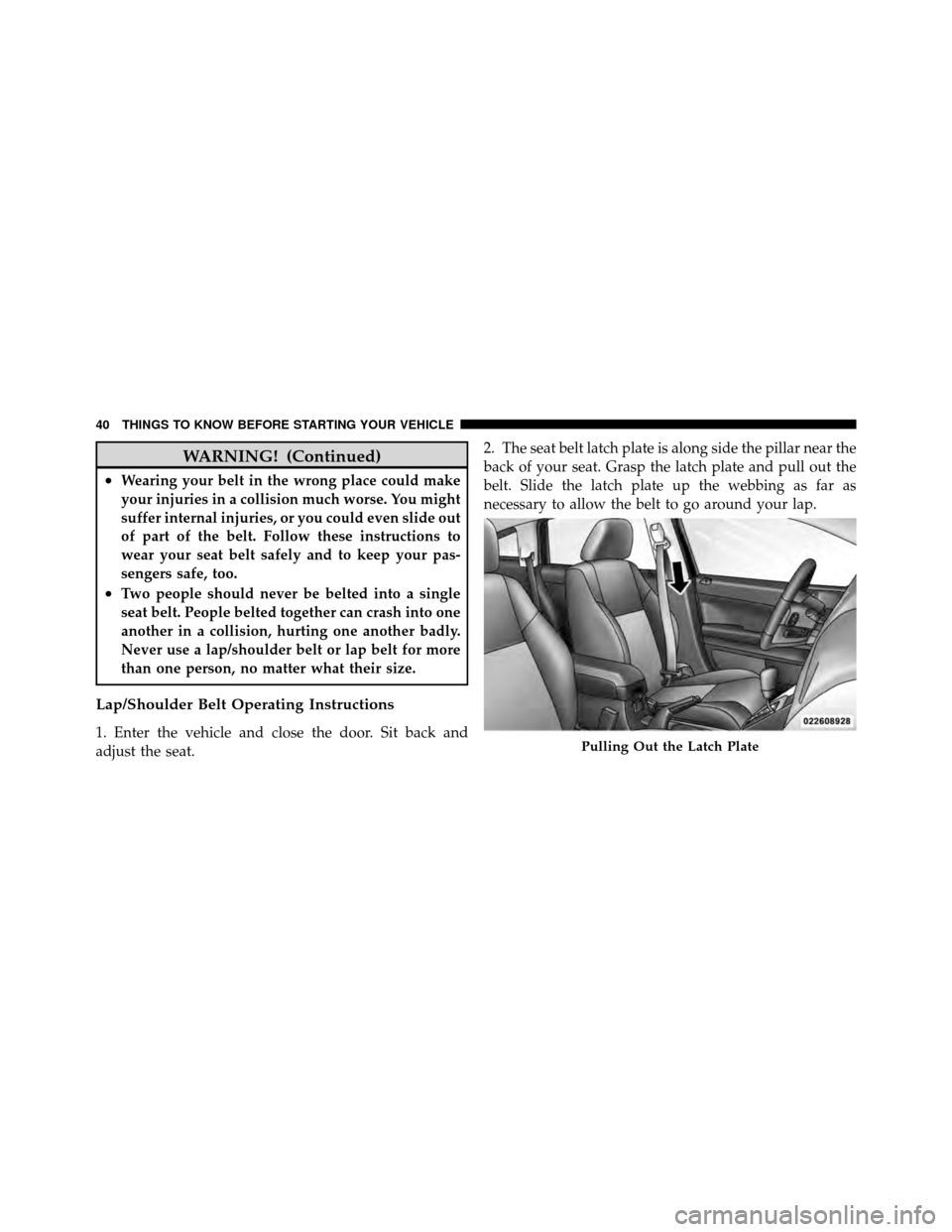
WARNING! (Continued)
•Wearing your belt in the wrong place could make
your injuries in a collision much worse. You might
suffer internal injuries, or you could even slide out
of part of the belt. Follow these instructions to
wear your seat belt safely and to keep your pas-
sengers safe, too.
•Two people should never be belted into a single
seat belt. People belted together can crash into one
another in a collision, hurting one another badly.
Never use a lap/shoulder belt or lap belt for more
than one person, no matter what their size.
Lap/Shoulder Belt Operating Instructions
1. Enter the vehicle and close the door. Sit back and
adjust the seat.2. The seat belt latch plate is along side the pillar near the
back of your seat. Grasp the latch plate and pull out the
belt. Slide the latch plate up the webbing as far as
necessary to allow the belt to go around your lap.Pulling Out the Latch Plate
40 THINGS TO KNOW BEFORE STARTING YOUR VEHICLE
Page 42 of 484
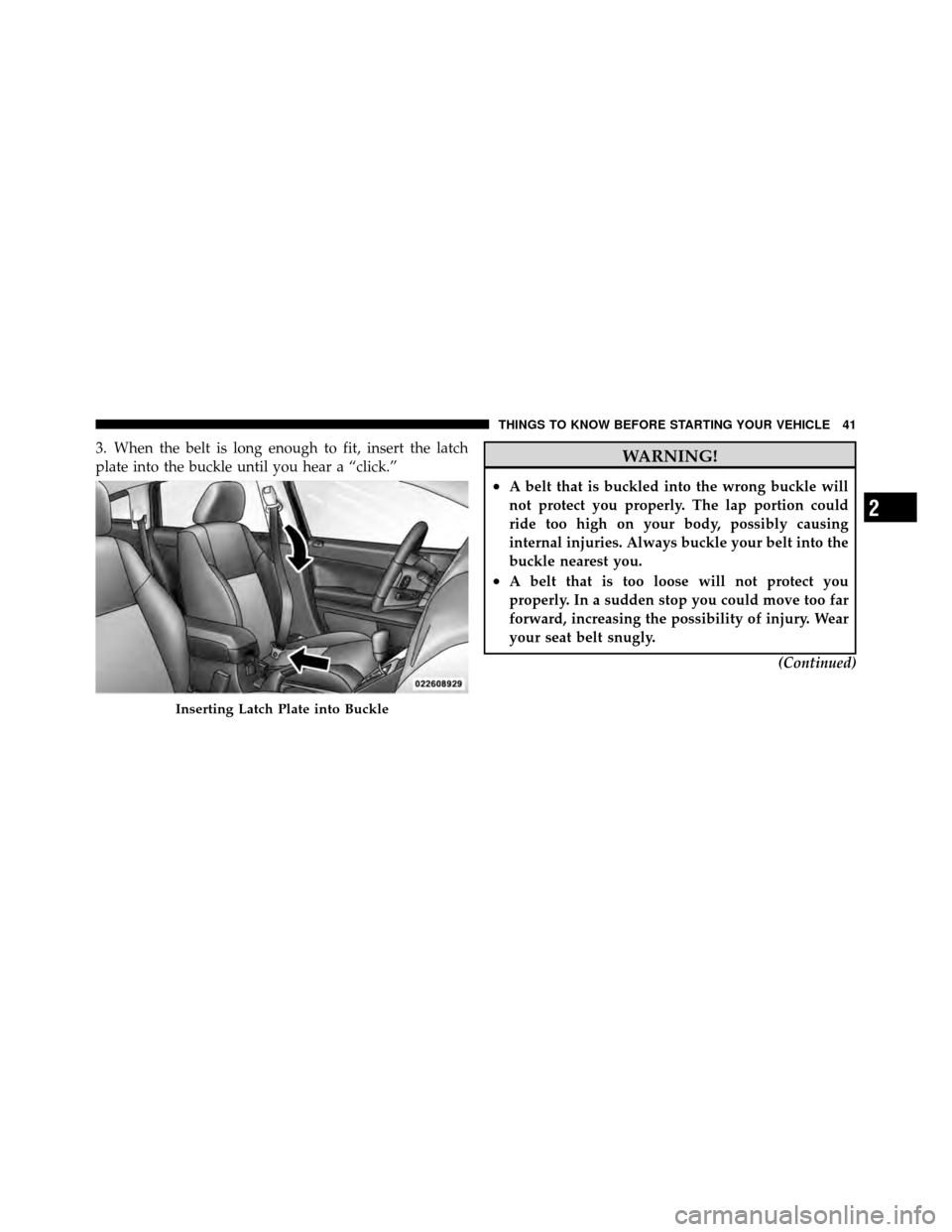
3. When the belt is long enough to fit, insert the latch
plate into the buckle until you hear a “click.”WARNING!
•A belt that is buckled into the wrong buckle will
not protect you properly. The lap portion could
ride too high on your body, possibly causing
internal injuries. Always buckle your belt into the
buckle nearest you.
•A belt that is too loose will not protect you
properly. In a sudden stop you could move too far
forward, increasing the possibility of injury. Wear
your seat belt snugly.(Continued)
Inserting Latch Plate into Buckle
2
THINGS TO KNOW BEFORE STARTING YOUR VEHICLE 41
Page 43 of 484
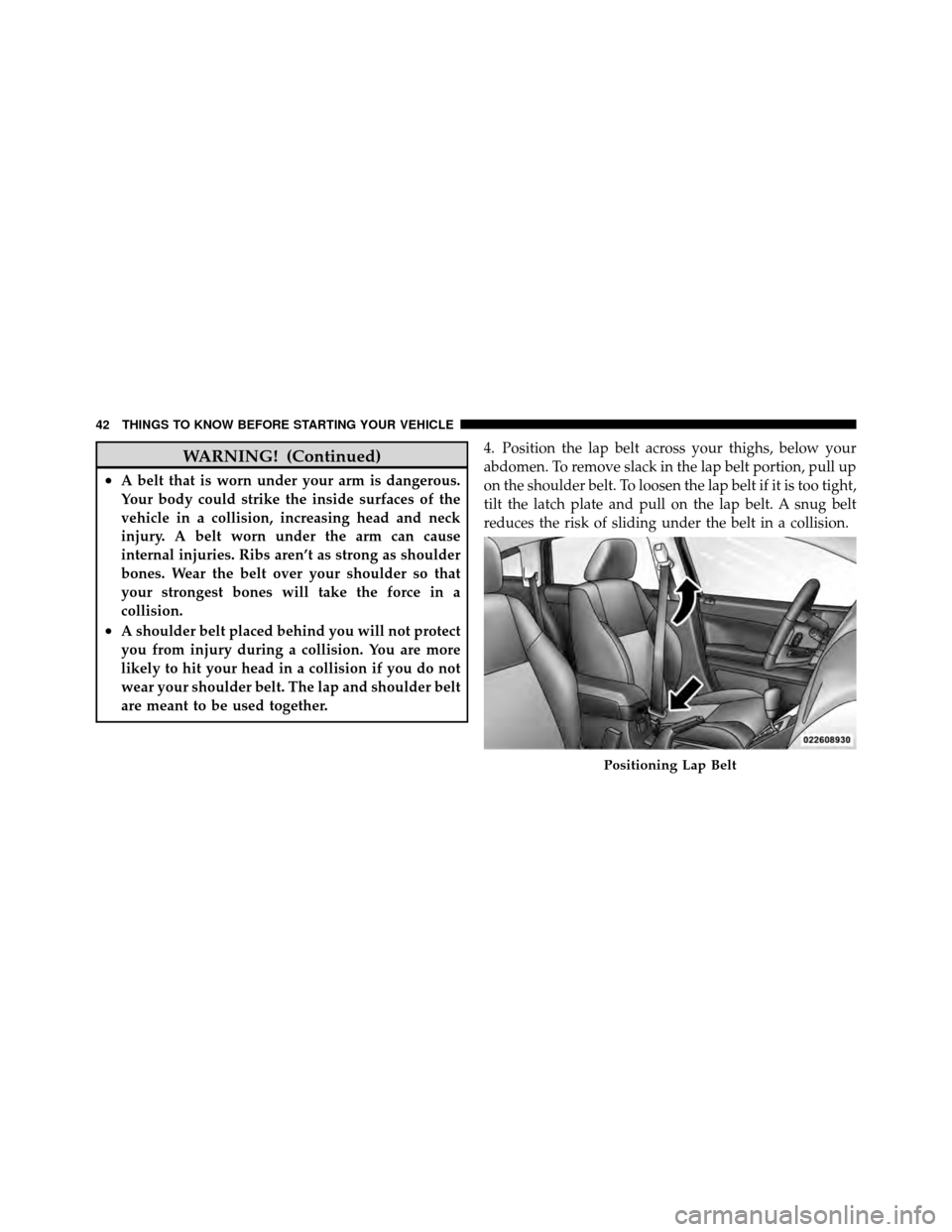
WARNING! (Continued)
•A belt that is worn under your arm is dangerous.
Your body could strike the inside surfaces of the
vehicle in a collision, increasing head and neck
injury. A belt worn under the arm can cause
internal injuries. Ribs aren’t as strong as shoulder
bones. Wear the belt over your shoulder so that
your strongest bones will take the force in a
collision.
•A shoulder belt placed behind you will not protect
you from injury during a collision. You are more
likely to hit your head in a collision if you do not
wear your shoulder belt. The lap and shoulder belt
are meant to be used together.4. Position the lap belt across your thighs, below your
abdomen. To remove slack in the lap belt portion, pull up
on the shoulder belt. To loosen the lap belt if it is too tight,
tilt the latch plate and pull on the lap belt. A snug belt
reduces the risk of sliding under the belt in a collision.
Positioning Lap Belt
42 THINGS TO KNOW BEFORE STARTING YOUR VEHICLE
Page 44 of 484
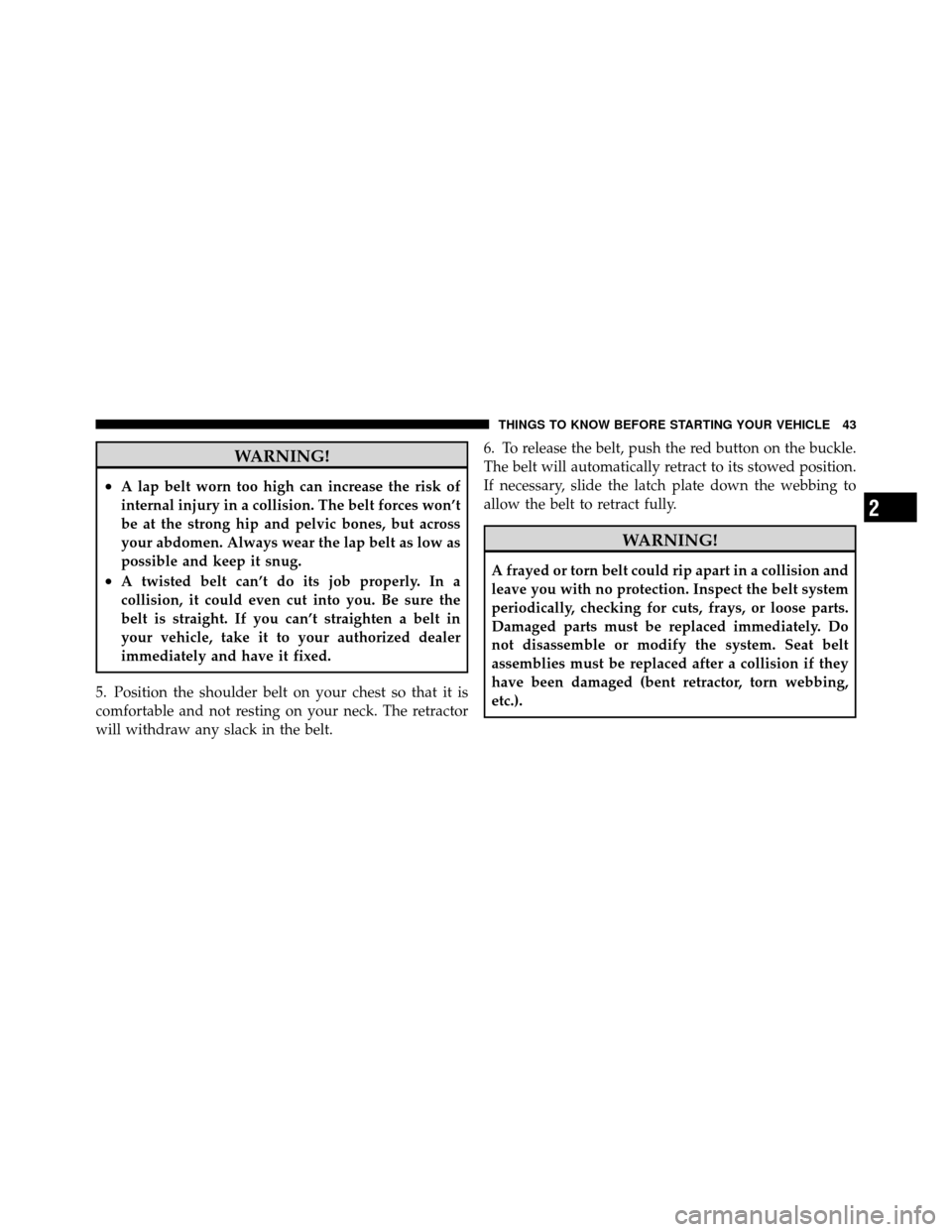
WARNING!
•A lap belt worn too high can increase the risk of
internal injury in a collision. The belt forces won’t
be at the strong hip and pelvic bones, but across
your abdomen. Always wear the lap belt as low as
possible and keep it snug.
•A twisted belt can’t do its job properly. In a
collision, it could even cut into you. Be sure the
belt is straight. If you can’t straighten a belt in
your vehicle, take it to your authorized dealer
immediately and have it fixed.
5. Position the shoulder belt on your chest so that it is
comfortable and not resting on your neck. The retractor
will withdraw any slack in the belt. 6. To release the belt, push the red button on the buckle.
The belt will automatically retract to its stowed position.
If necessary, slide the latch plate down the webbing to
allow the belt to retract fully.
WARNING!
A frayed or torn belt could rip apart in a collision and
leave you with no protection. Inspect the belt system
periodically, checking for cuts, frays, or loose parts.
Damaged parts must be replaced immediately. Do
not disassemble or modify the system. Seat belt
assemblies must be replaced after a collision if they
have been damaged (bent retractor, torn webbing,
etc.).
2
THINGS TO KNOW BEFORE STARTING YOUR VEHICLE 43
Page 45 of 484
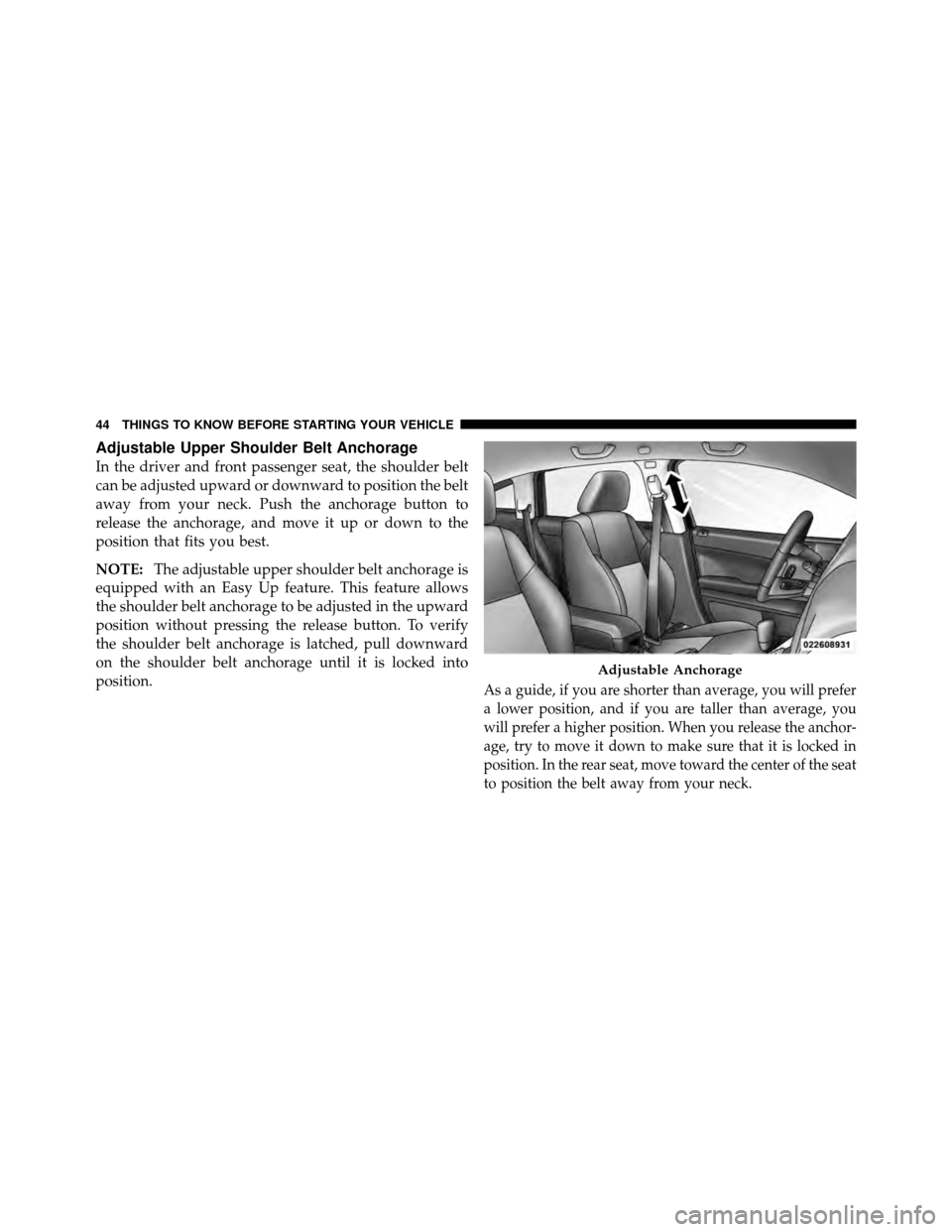
Adjustable Upper Shoulder Belt Anchorage
In the driver and front passenger seat, the shoulder belt
can be adjusted upward or downward to position the belt
away from your neck. Push the anchorage button to
release the anchorage, and move it up or down to the
position that fits you best.
NOTE:The adjustable upper shoulder belt anchorage is
equipped with an Easy Up feature. This feature allows
the shoulder belt anchorage to be adjusted in the upward
position without pressing the release button. To verify
the shoulder belt anchorage is latched, pull downward
on the shoulder belt anchorage until it is locked into
position.
As a guide, if you are shorter than average, you will prefer
a lower position, and if you are taller than average, you
will prefer a higher position. When you release the anchor-
age, try to move it down to make sure that it is locked in
position. In the rear seat, move toward the center of the seat
to position the belt away from your neck.
Adjustable Anchorage
44 THINGS TO KNOW BEFORE STARTING YOUR VEHICLE
Page 46 of 484
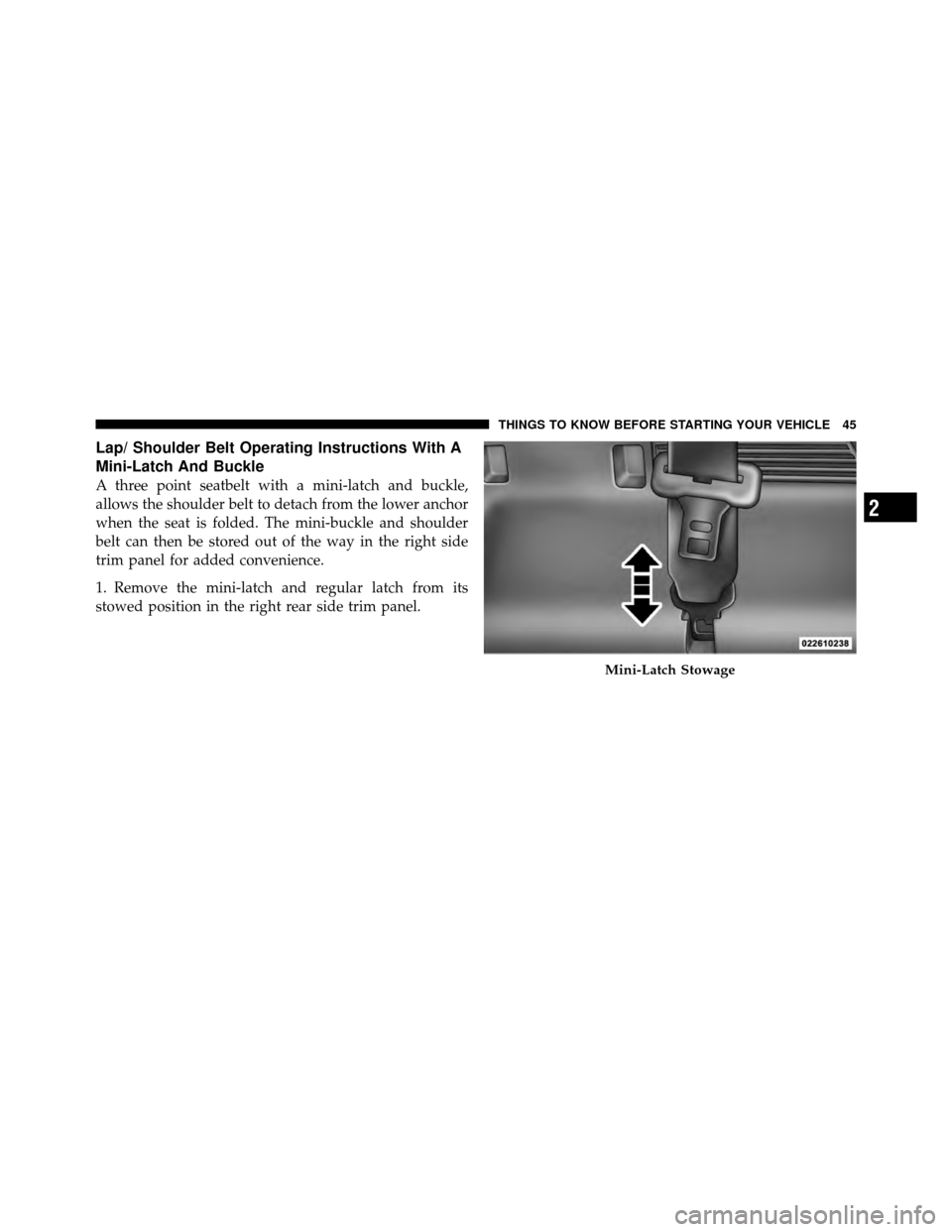
Lap/ Shoulder Belt Operating Instructions With A
Mini-Latch And Buckle
A three point seatbelt with a mini-latch and buckle,
allows the shoulder belt to detach from the lower anchor
when the seat is folded. The mini-buckle and shoulder
belt can then be stored out of the way in the right side
trim panel for added convenience.
1. Remove the mini-latch and regular latch from its
stowed position in the right rear side trim panel.
Mini-Latch Stowage
2
THINGS TO KNOW BEFORE STARTING YOUR VEHICLE 45
Page 47 of 484
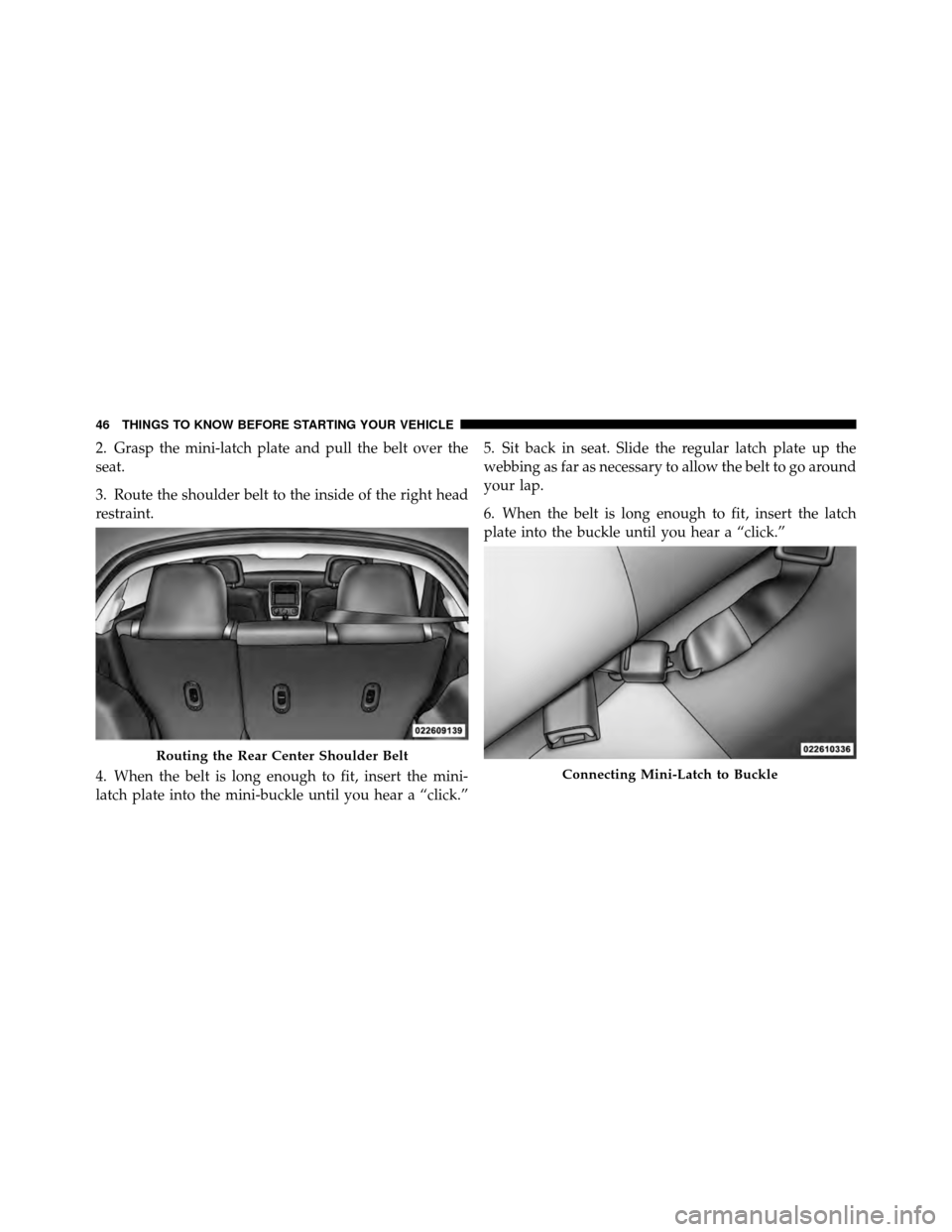
2. Grasp the mini-latch plate and pull the belt over the
seat.
3. Route the shoulder belt to the inside of the right head
restraint.
4. When the belt is long enough to fit, insert the mini-
latch plate into the mini-buckle until you hear a “click.”5. Sit back in seat. Slide the regular latch plate up the
webbing as far as necessary to allow the belt to go around
your lap.
6. When the belt is long enough to fit, insert the latch
plate into the buckle until you hear a “click.”
Routing the Rear Center Shoulder Belt
Connecting Mini-Latch to Buckle
46 THINGS TO KNOW BEFORE STARTING YOUR VEHICLE
Page 48 of 484
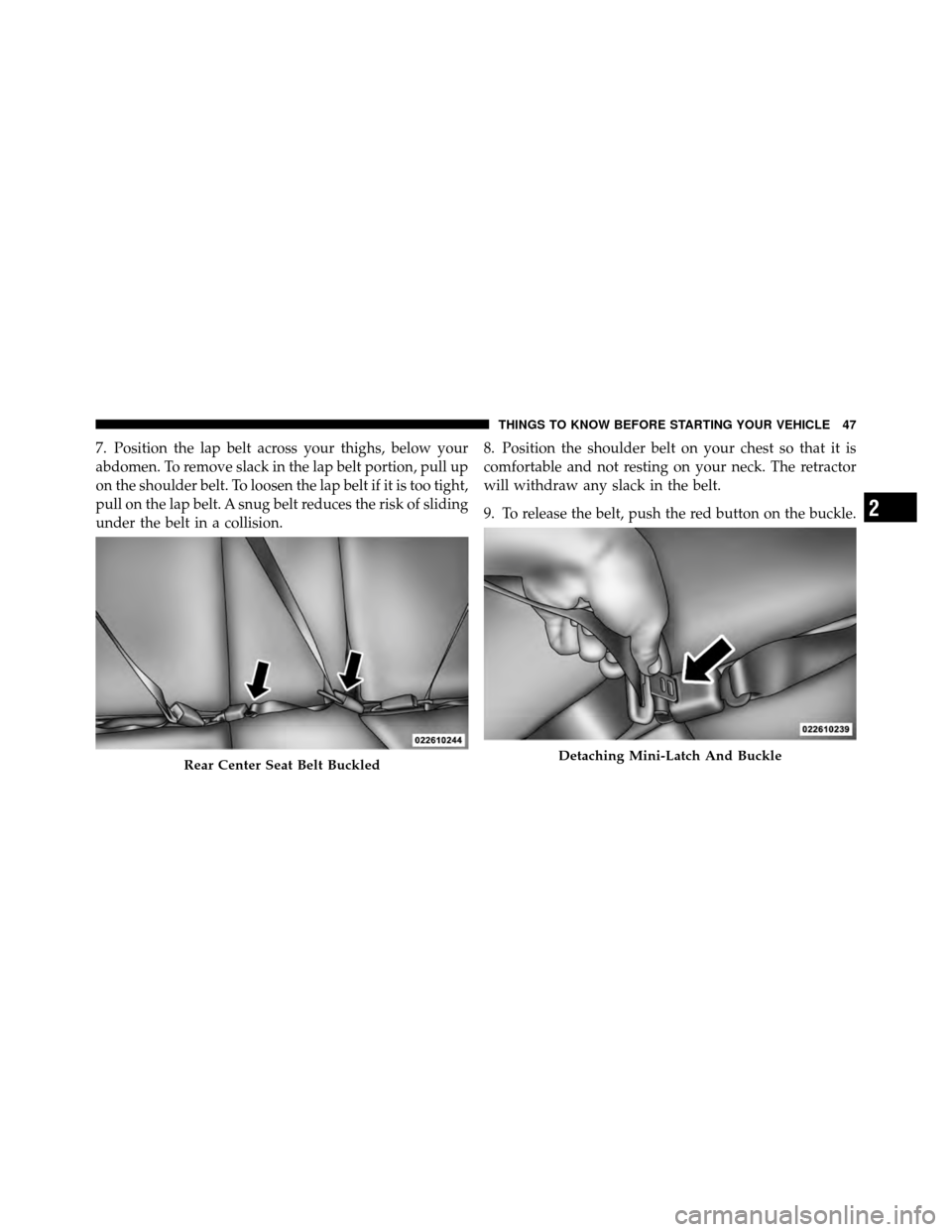
7. Position the lap belt across your thighs, below your
abdomen. To remove slack in the lap belt portion, pull up
on the shoulder belt. To loosen the lap belt if it is too tight,
pull on the lap belt. A snug belt reduces the risk of sliding
under the belt in a collision.8. Position the shoulder belt on your chest so that it is
comfortable and not resting on your neck. The retractor
will withdraw any slack in the belt.
9. To release the belt, push the red button on the buckle.
Rear Center Seat Belt BuckledDetaching Mini-Latch And Buckle
2
THINGS TO KNOW BEFORE STARTING YOUR VEHICLE 47
Page 49 of 484

10. To disengage the mini-latch from the mini-buckle for
storage, insert the regular latch plate into the black
button on the top of the mini-buckle. The belt will
automatically retract to its stowed position. If necessary,
slide the latch plate down the webbing to allow the belt
to retract fully. Insert the mini-latch plate into the slot
provided in the trim panel.
Lap/Shoulder Belt Untwisting Procedure
Use the following procedure to untwist a twisted lap/
shoulder belt.
1. Position the latch plate as close as possible to the
anchor point.
2. At about 6 to 12 in (15 to 30 cm) above the latch plate,
grasp and twist the belt webbing 180 degrees to create a
fold that begins immediately above the latch plate.3. Slide the latch plate upward over the folded webbing.
The folded webbing must enter the slot at the top of the
latch plate.
4. Continue to slide the latch plate up until it clears the
folded webbing.
Automatic Locking Retractors (ALR) Mode — If
Equipped
In this mode, the shoulder belt is automatically pre-
locked. However, the belt will still retract to remove slack
in the shoulder belt. Use the Automatic Locking Mode
any time a child safety seat is installed in a seating
position that has a seat belt with this feature. Children
12 years old and under should be properly restrained in
the rear seat.
48 THINGS TO KNOW BEFORE STARTING YOUR VEHICLE
Page 50 of 484
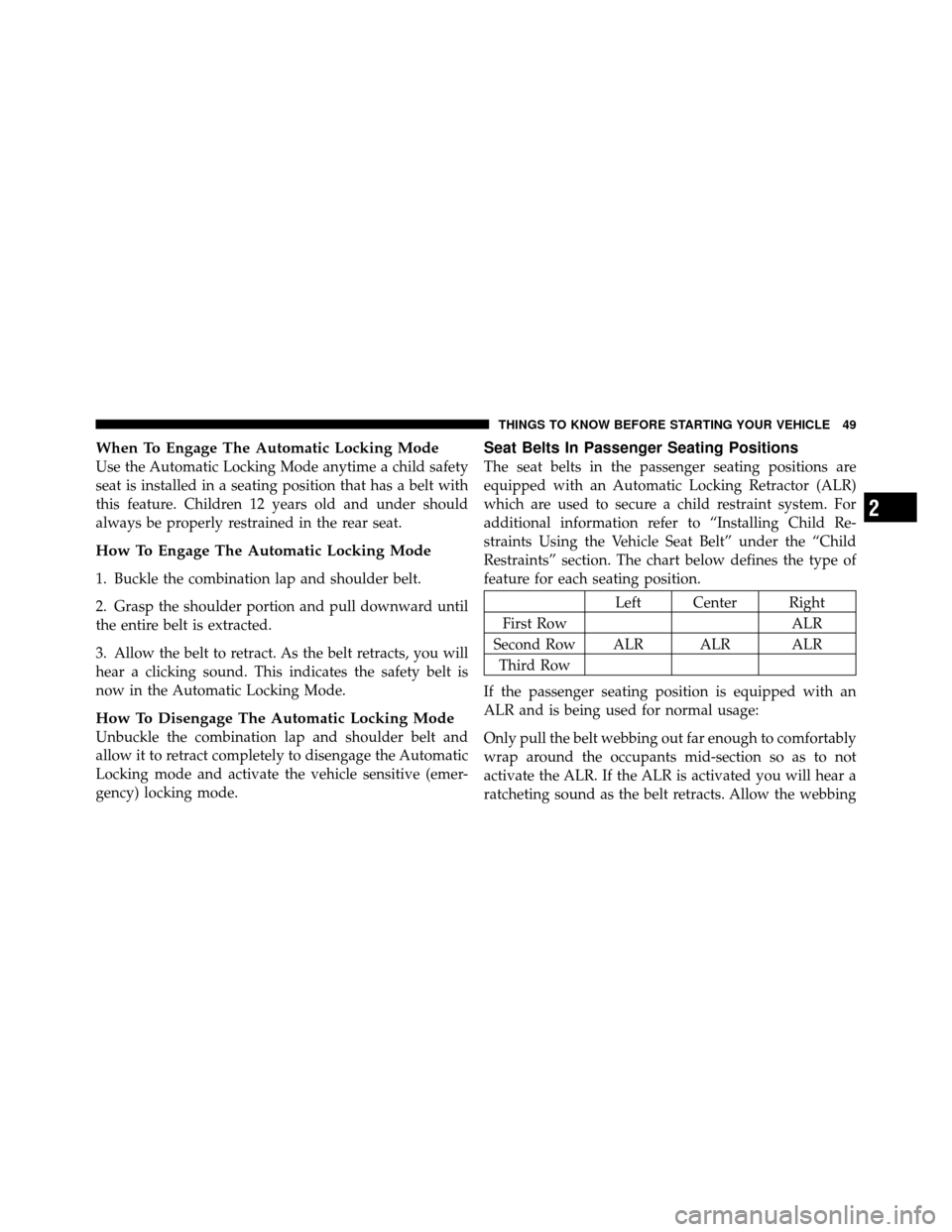
When To Engage The Automatic Locking Mode
Use the Automatic Locking Mode anytime a child safety
seat is installed in a seating position that has a belt with
this feature. Children 12 years old and under should
always be properly restrained in the rear seat.
How To Engage The Automatic Locking Mode
1. Buckle the combination lap and shoulder belt.
2. Grasp the shoulder portion and pull downward until
the entire belt is extracted.
3. Allow the belt to retract. As the belt retracts, you will
hear a clicking sound. This indicates the safety belt is
now in the Automatic Locking Mode.
How To Disengage The Automatic Locking Mode
Unbuckle the combination lap and shoulder belt and
allow it to retract completely to disengage the Automatic
Locking mode and activate the vehicle sensitive (emer-
gency) locking mode.
Seat Belts In Passenger Seating Positions
The seat belts in the passenger seating positions are
equipped with an Automatic Locking Retractor (ALR)
which are used to secure a child restraint system. For
additional information refer to “Installing Child Re-
straints Using the Vehicle Seat Belt” under the “Child
Restraints” section. The chart below defines the type of
feature for each seating position.
Left Center Right
First Row ALR
Second Row ALR ALR ALR Third Row
If the passenger seating position is equipped with an
ALR and is being used for normal usage:
Only pull the belt webbing out far enough to comfortably
wrap around the occupants mid-section so as to not
activate the ALR. If the ALR is activated you will hear a
ratcheting sound as the belt retracts. Allow the webbing
2
THINGS TO KNOW BEFORE STARTING YOUR VEHICLE 49